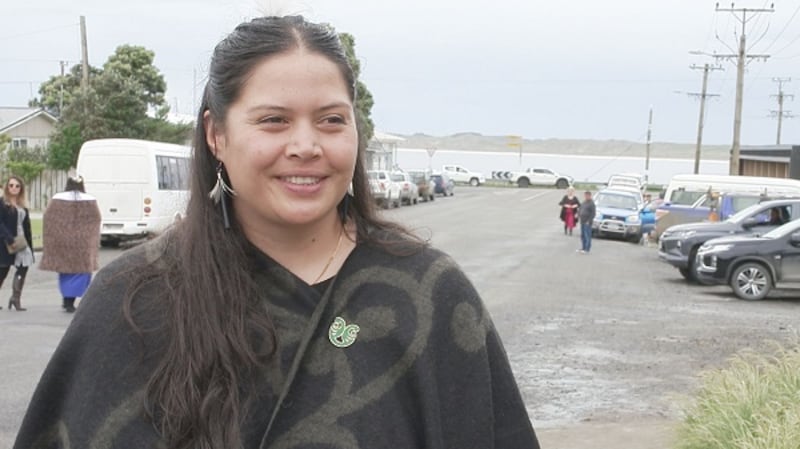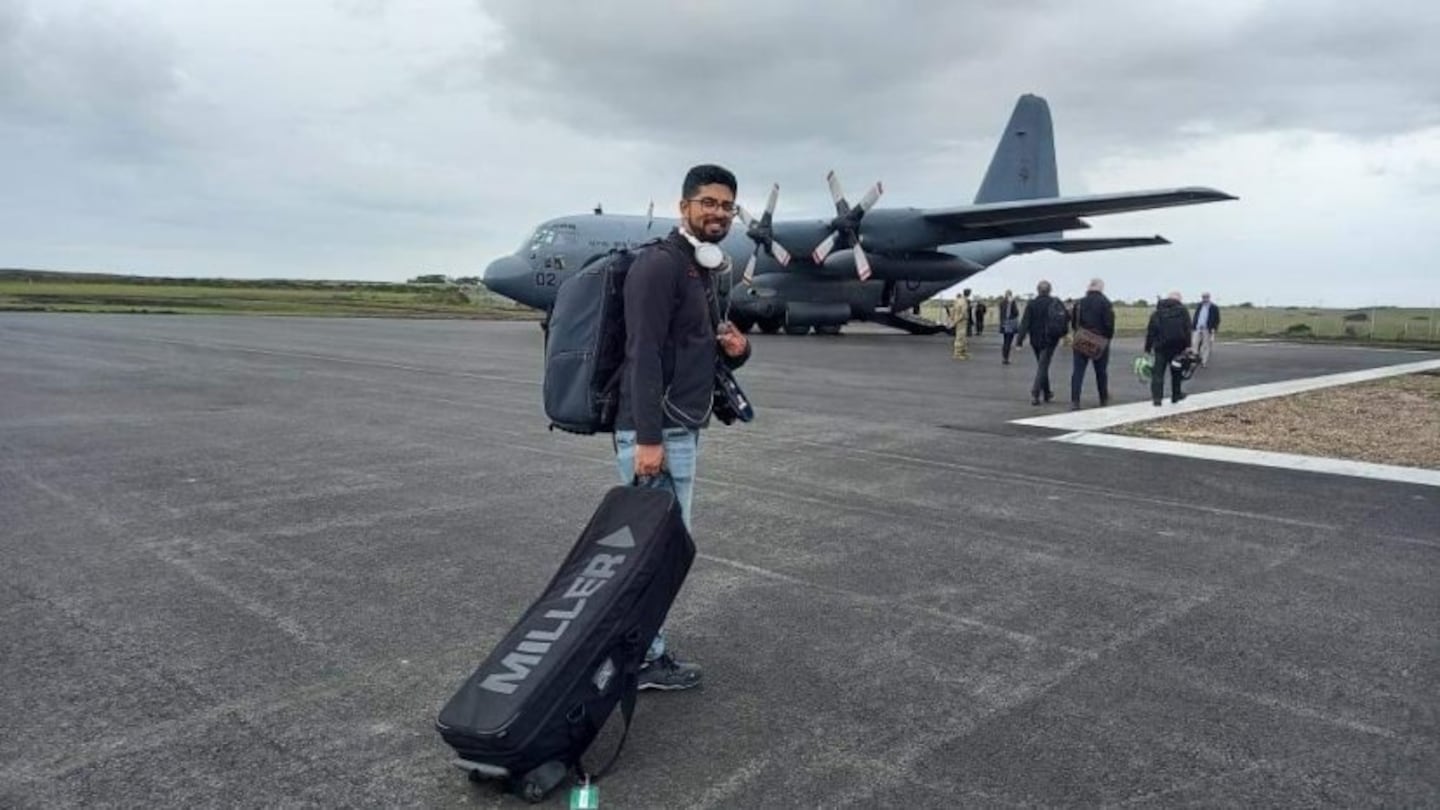“Did you get here on the Herc?” Te Amo asks me, referring to the Hercules aircraft that had brought the media contingent accompanying the Prime Minister to Wharekauri.
"Āe," I say, “And it was pretty cold in there.” I leave out other details about the adventure ride- the excitement of travelling on a military aircraft, the rugged toilet facilities on board, and the landing with no warning that made for my scariest flying moment. (And I have taken mountain flights in Nepal).
We are standing outside the new Chatham Islands Museum building that had been opened the same morning, with the PM unveiling the plaque. My eyes are on the clouds; the rain has stopped. It had come lashing down an hour ago just as the pōwhiri started, welcoming the PM on her first trip to the island. It was also the first visit by a sitting Prime Minister in ten years.
Also in attendance were Rino Tirikatene (MP for Te Tai Tonga, the Māori electorate that covers the Chathams), Paul Eagle (MP for Rongotai whose electorate also covers the Chathams), Kieran McAnulty, Minister for Disaster Management, who had earlier in the day announced a water safety scheme for the islands, and Kelvin Davis, Minister for Māori Crown Relations. (Ngāti Mutunga o Wharekauri had signed an agreement in principle with the Crown). They were welcomed by what I thought was a greater part of the island's population who seemed unfazed by the showers.
“Give me two minutes,” I say and run in to grab my camera away from a media scrum inside the museum where the prime minister and her parliamentary colleagues are making their announcements and other seemingly important matters. I have to choose between this kaupapa and that. I look around the media scrum and know every political story will be covered by the other media outlets- I want to find out about the oranga of the reo. I pull my mic stand away from the scrum and head out.
Only kōhanga reo
Te Amo Amaru-Tibble (Ngāti Mutunga o Wharekauri) is a teacher at the only kōhanga reo in Wharekauri, which has just over 600 inhabitants. And this presents a unique opportunity for revitalising the reo, she says.
"Ko te tino painga kāore he whare kōhungahunga i kō atu ki te kōhanga reo, nō reira ka haere mai ngā mokopuna katoa o tēnei motu ki te kōhanga reo," she says
(The great thing is that there is no other childhood centre, and so every child on the island goes to the kōhanga reo.)
That is a positive in a place with quite a few challenges. One of the challenges, says Amaru-Tibble, is that there is no kura kaupapa or whare kura on the island, and so once the kids are done with kōhanga reo, that is often the end of their formal learning in te reo Māori.
Kura Kaupapa education is needed for tamariki to continue their journey into te ao Māori.
One of the biggest problems, says Whaea Ririana Tangohau-Tuuta from Kōhanga Reo o Wharekauri (and who, in the words of Amaru-Tibble, has been on the ground for 40 years bringing the mokopuna up in te reo Māori), is that only a few families on the island are well-versed in their language, and so many of the parents are learning, just as their kids are.
Nothing holds back the 21 kids enrolled in the kōhanga reo, though, Whaea Ririana says. "Kei ia rātou he kore e whakamā ki te kōrero ahakoa kore rātou e mohio."
(They are not shy to speak the language even when they don't know something.)
"Ko te mea nui, ko te reo Māori ka rāngona," says Amaru-Tibble.
(The important thing is the transmission of the Māori language.)

Te Amo Amaru-Tibble.
A difficult history
"Pai tō reo," says Amaru-Tibble to me, even though I threw only a couple of my questions in te reo Māori.
I thank her and rush back in to try and catch the remainder of the media stand-up inside the museum- a museum that will "preserve and share the unique history of the Chathams," Ardern says.
“You can see captured within these walls..." she signals around the room she is standing in, “some of that important and unique history that you won’t find anywhere else.”
It is a history that is also as difficult as it is unique. The Moriori were the first inhabitants (waina-pono) on Rēkohu and arrived on the islands, by most accounts, around 700-1000 years ago.
Following initial warring among tribes, peace was established and the Moriori lived for most of their history under Nunuku's Law which forbade killing.
First contact
The first European contact happened in the late 18th century when an officer on board a British ship that was blown off course planted the British flag on the island and 'annexed' it in the name of King George III. The islands are named after this ship -the Chatham. The European 'discovery' was followed by the arrival of whalers and sealers, exposing the Moriori to diseases they had no immunity against.
But their numbers truly dwindled after the invasion of the islands by Ngāti Mutunga and Ngāti Tama from Taranaki. Since the Moriori would not break Nunuku's law, hundreds were killed at the hands of the new arrivals and the remainder of the population enslaved. By the time they were released from slavery in 1863, only about 100 Moriori remained. A Native Land Court looking at competing claims had also awarded 97% of the land to Ngāti Mutunga in 1870.
Today, a number of people on the islands trace their lineage to both Moriori and Ngāti Mutunga o Wharekauri (as well as European). A Moriori settlement signed with the Crown passed its third reading last year, encompassing a Crown apology, financial redress and the transfer of culturally significant land and waters. Now Ngāti Mutunga o Wharekauri is in the first stage of its claim.
Standing together
Te Tai Tonga MP Rino Tirikatene is asked if it is a tough political landscape to navigate, "I think in the Māori world, there are always issues," he responds, adding it is heartening to see relationships at present. "It was important to see Moriori and Ngāti Mutunga standing together on the taumata (this morning), representing the whole of the Chathams," he says.
I get an urge to ask this question to someone with hokopapa Moriori, even as I feel less-than-qualified to broach the topic. The conversation in the media stand-up moves to a lighter (but also important) topic of seafood and what the politicians are carrying home, and I see from the corner of my eye Maui Solomon leaving the whare. I proceed to pull out of the stand-up for the second time.
“We inherit history,” says Maui Solomon, chief executive of Hokotehi Moriori Trust on Rēkohu. “We don’t make it."
And understanding history, both the good parts and the bad parts are important, he says, "to gain a better insight into who we are as people today and accept that these things happened and then we can move on together.”
“We have more things that unite us moving forward than things that divide us looking backwards,” Solomon. says
Ta rē Moriori
“There’s been a lot of misinformation that has been taught in schools across New Zealand in the past hundred years,” he says, alluding to the Moriori myth. (I first heard this pervasive story from my flatmate when I moved to Aotearoa, and many times since.)
The gist of the myth is that the Moriori lived in mainland New Zealand. The Māori arrived, killed them, and depending on who is telling you the story (and how emboldened they feel), ate them.
The myth has been debunked many times and yet persists. Another myth is that the Moriori went extinct in the last century with the death of Tommy Solomon.
Today the imi (iwi) has over 1700 registered members. The 2013 census saw 728 people indicate affiliation to Moriori.
Solomon is hopeful of setting up a museum at Te Kōpinga marae. But the newly established museum is also an initiative Moriori are pleased to be a part of, he says. "This is just another step in terms of Moriori being able to tell our own story."
Part of the Moriori story is the language - a language that died out over a hundred years ago. But efforts are being made to re-learn and revive it.
“We did seek to have Moriori recognised as an official language. We didn't get that over the line,” says Solomon. “But maybe that’s something we can look at again in the future.”
But how does one go about reviving an extinct language?
“In terms of learning the language, we are in kindergarten," Solomon says. "But we have got an app, we have got webinars, and we are developing resources”- an initiative that is being supported by Te Taura Whiri and Te Mātāwai.
Solomon is hopeful. “As a people, we have to re-learn our language, and I look forward to that," Solomon says.
This article was updated with spelling corrections and an amended quote on 3 December.



